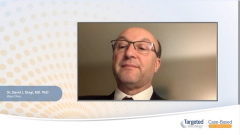
Navigating Unmet Needs and Challenges in Multiple Myeloma Treatment
Episodes in this series

Transcript:
David M. Dingli, MD, PhD: I believe that these drugs are here to stay. I think there’s going to be a demand for these products because of the response rates and the duration of responses. We owe it to patients [to] provide them these therapeutic options. Ideally, we provide them these therapeutic options as close to home as possible, given that they need to be administered weekly, at least initially. The barriers that I can see include the fact that some of these adverse effects may be a little bit unfamiliar for the community oncologist, given that many community oncologists are not going to have multiple patients with this disease at any time. But like everything else, we can all learn how to take care of patients with these diseases and with these therapies.
Taking care of a patient with multiple myeloma is like the saying that it takes a village to raise a child. The same is for these patients. With the partnership between the larger centers and the community oncologists, I think we can safely provide this therapeutic option for patients with relapsed/refractory disease. These are not just words. I have done this, and my colleagues have done this already for several months. We start patients locally with these agents and when the patient is stable on therapy, without the CRS [cytokine release syndrome] and ICANS [immune effector cell-associated neurotoxicity syndrome], we transition the care to the local oncologist, and these local oncologists can continue to treat these patients with these agents, usually without many problems.
I personally have patients treated in multiple small towns in the United States in collaboration with the community oncologist. I urge the community oncologists to embrace the use of these agents. They are very powerful. They result in deep responses, rapid responses, durable responses. In time, potentially, we can reduce the frequency of dosing, so it becomes less of a burden on patients. But we owe it to patients to offer them these agents because of their impact on survival.
Unmet needs remain because as powerful as these drugs are, most patients will ultimately progress, so drugs with novel mechanisms of action are needed. We need to learn how to sequence these agents properly, and there are several questions. What will be the optimal use of these agents sequentially? Should we give a bispecific antibody followed by a different bispecific antibody? Should we allow some time for a new reconstitution between the use of these 2 agents in this big class of drugs?
We need to understand why these agents are failing, because there are different mechanisms of how these agents fail that require different solutions. The unmet needs remain because these drugs will, like everything else we have right now for multiple myeloma, ultimately fail and we will need to move on to a different class of agents, but the future looks very bright. We have additional targets that have been identified, such as the…receptor CD38 that is being considered as a target.
We have new agents such as the cell mods that can be quite effective in this context in the appropriate setting. Venetoclax is a potential treatment option for some patients. There’s a lot of activity going on in this disease, a lot of research that is going to provide new targets of therapy. We need to study new combinations of agents. Of course, historically, when a therapy that works in late-stage disease is studied earlier, the response rates are higher.
The other unmet need that I would like to address here is the issue of extramedullary disease. This is a phenomenon that unfortunately we’re seeing more with relapsed/refractory patients. The disease becomes more aggressive. It starts growing independent of the bone marrow microenvironment. We find plasmacytomas in soft tissues, in the liver, in the lungs, in the brain, under the skin, etc. We need therapies that can help us treat patients at that stage of their illness.
Transcript is AI-generated and edited for readability.








































